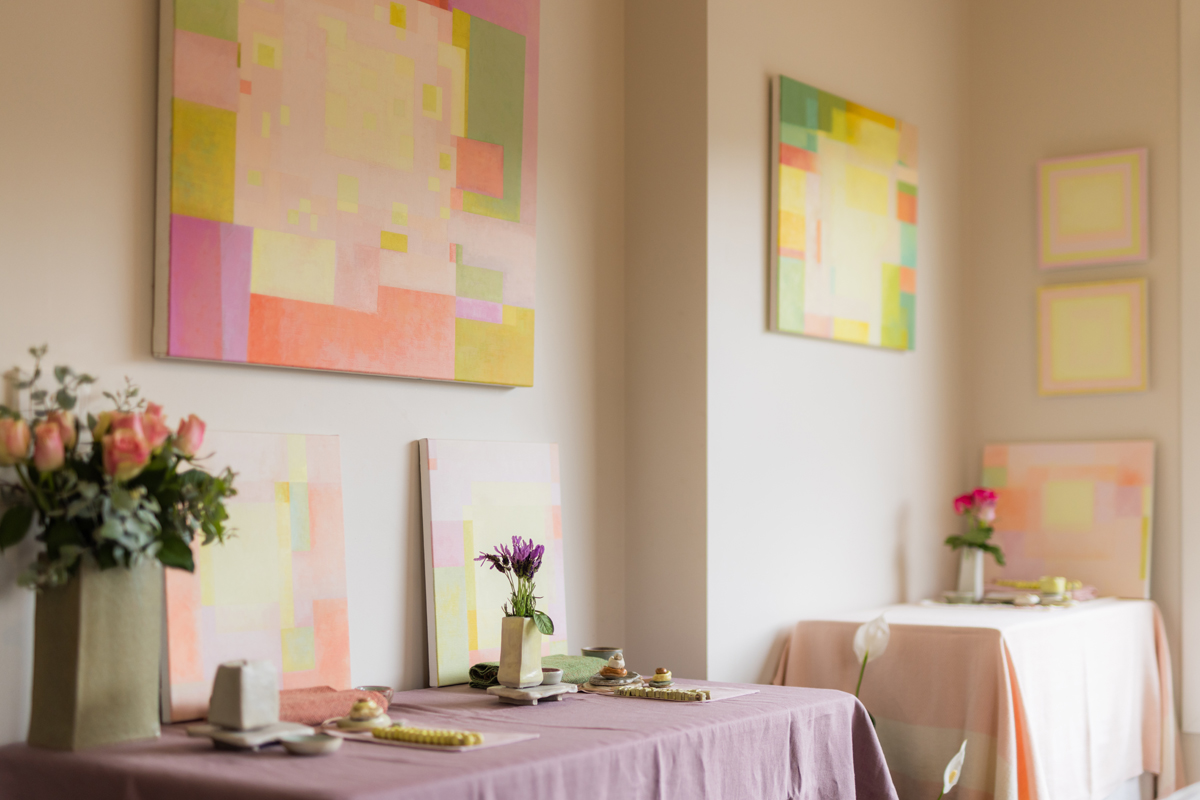
Art as a way to make space
and time for contemplation
“The first symptom of the process of killing our dreams is the lack of time.”
—Paulo Coelho, “The Pilgrimage”
DR SUZANNE MOSS is an Australian artist, abstract and meditative art teacher and life coach trained in Spiritual Care. She composes her paintings and ceramics to create personal spaces for contemplation and inner joy.
In this month’s guest post for The Culturium, Suzanne introduces us to her passion project, Morning Sanctuary—a profound and stimulating concept that invites us to create a private space, in which we may discover the silence without and the stillness within.
Zeitgeist
What might an artist offer in a zeitgeist stained with the blood of innocent people, loss of democratic processes, Orwellian rhetoric, environmental devastation and a sense of urgency that leaves meaning in its wake? More of the same, or something transcendent?
Contemporary paintings, sculptures and installations by German artist Anselm Kiefer and Japanese artist Yayoi Kusama recently seen at San Francisco’s Museum of Modern Art demonstrate two entirely different responses. The devastation suggested by Keifer’s eerily stark aftermath-of-war paintings offer an exhortation in the style of German-American political theorist Hannah Arendt—Love the world. Think what you do. Also powerful, Kusama offers her love of depicting pumpkins in her art. One takes the bull by the horns and the other, takes the pumpkin by the stalk and covers it, adoringly, obsessively, in spots. Both answer Arendt in their own way.
Artists provide space—actual and metaphoric—to remember our humanity; to be moved and reassured by that which goes beyond the constraints of everyday words; to seek art that expresses the ecstasy and tragedy of being human. Perhaps that’s what people were seeking when they crowded into art museums in record numbers during the days following 9/11 reported by Michael Kimmelman in The New York Times. Also noted by Drusilla Modjeska in Timepieces, she muses, “When you stand in front of a painting with time ticking past inside you, it’s as if the image held in paint, the mark of the brush on canvas, steps forward and for a moment stills that internal clock.”
More toward the Kusama end of the spectrum, Morning Sanctuary—an exhibition of my abstract paintings and ceramics, the workshop and mini-documentary about composing contemplative space with art—provides ways to shift from skimming the surface of life to calm, centred being.
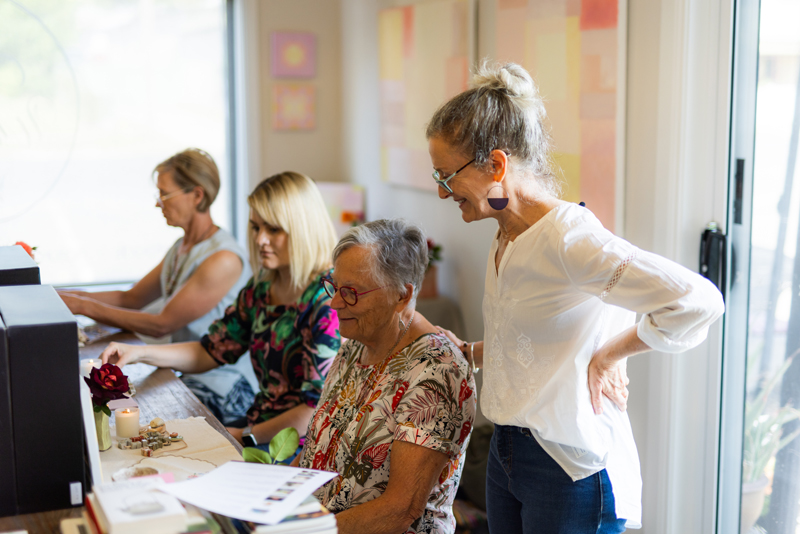
Morning Sanctuary Workshop.
Image: © Grant Hardwick
Contemplative art
My intention to offer immersive experience of contemplative space originated during my doctorate—Painting Light, Touching Space (2006–10). Intrigued by how colour and material qualities contribute to a poetics of space, I examined numerous art works: Fra Angelico’s San Marco fresco cycle and paintings by J.M.W. Turner, Giorgio Morandi, Mark Rothko, Agnes Martin and Howard Taylor, informing my development of a large series of luminous geometric abstract paintings.
When paintings offer qualities of luminosity and spaciousness, they’re conducive to resting the eyes. When the eyes rest, the mind rests too. Perhaps more likely to be abstract paintings, the challenge is to look for longer; to see when one’s mind says there’s nothing to see, and instead feel and intuit beyond the names of things rather than naming what has been depicted and moving on to the next thing. Abstraction can be frustrating because it doesn’t deliver straight up, it asks for you to make your own meaning and for that, more time is needed.
Lucy Lippard, on looking at abstract, monotonal painting observes (in Changing: Essays in Art Criticism), “The spectator might find the work dull, then impossibly dull; then surprisingly, he breaks out on the other side of boredom into an area that can be called contemplation.” Counter-cultural to the pace of contemporary life, contemplation, meditation, prayer and the creative life present the conflict of not complying with mainstream demands. And the rewards can be extraordinary since brilliant ideas for purposeful steps forward do not happen in a stressed state. Time and space are needed for imagination, inspiration and to hear the “still, small voice”.
Renowned patrons of the Rothko Chapel, John and Dominique de Menil, believed that abstract art offered alternative and spiritual ways of approaching reality. Dominique de Menil is quoted in The Menil Collections’ April news: “In a world cluttered with images only abstract art can bring us to the threshold of the divine.”
Epiphanies are in the realm of the divine, and stopping is necessary for such sudden realizations to occur. CEO Keith Cunningham, author of The Road Less Stupid and mentor of Robert Kawasaki—of Rich Dad, Poor Dad fame—attributes his considerable success to stopping for Thinking Time (his capitals). Two to three times per week, Cunningham schedules an hour of strict solitude in an office reserved for this purpose, with a particular chair, desk, journal, pen, thinking posture, timing and approach to asking and answering questions.
A ritual, no less, Cunningham’s Thinking Time is linked to early humanities’ creation of sacred space and visioning in the caves. Intentional compositions of art can continue to provide designated space, like portals into imagining possible futures to create and nurture our dreams.
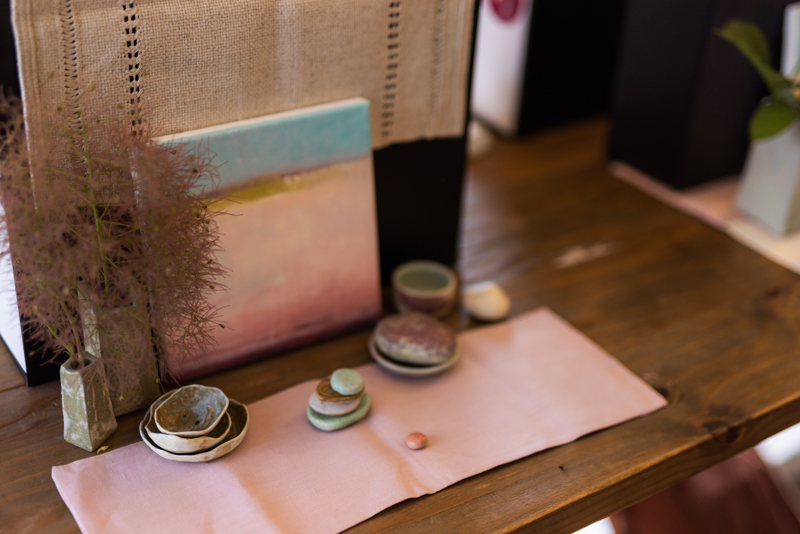
Morning Sanctuary Workshop.
Image: © Grant Hardwick
Yearning
The origins of Morning Sanctuary happened under great duress. Yearning to create a space to be, think through what was happening and restore a sense of belonging to myself, there’d not been time to come to terms with very disturbing events.
Reading Coleman Barks’ translation of Rumi’s Love Dogs, one realizes yearning is not met by seeking elsewhere but rather by its expression:
Listen to the moan of a dog for its master.
that whining is the connection.
What does one do when there’s no space to cry out like that unless driving alone, walking in a storm or at a particular kind of funeral? There’s surrender to what is and there’s giving up. Unable to create a sense of the sacred with mass-produced objects, I confess to giving up on my yearning, for a time. At that time, the epiphany called to focus on what I loved; to remember the joy of being and love life again.
Purposeful tasks have a way of resurfacing. Several years later, I began to compose Little Meditation Spaces. The first of these was exhibited in 2021, ten years after the first impetus. The following year, several more boxed sets were made and shared with participants during one of my meditative art workshops. From that experience, I realized the need to codify a method for composing and using contemplative space, which resulted in the Morning Sanctuary workshop and short film.
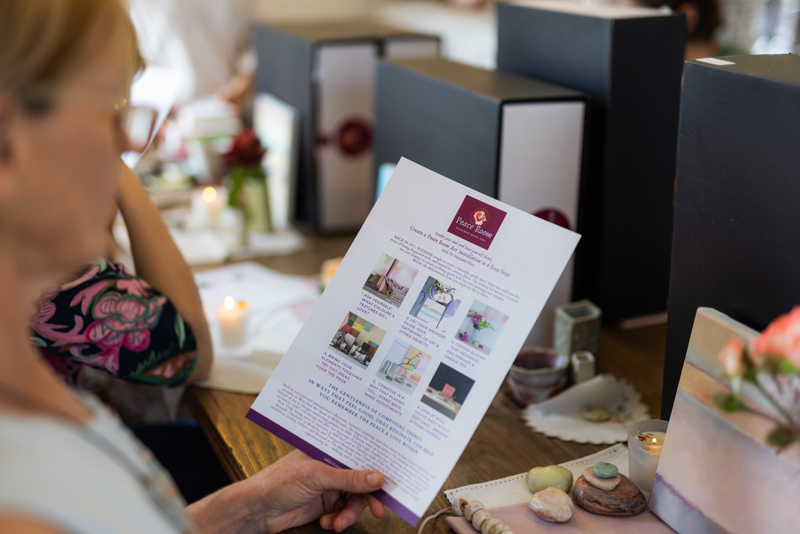
Morning Sanctuary Workshop.
Image: © Grant Hardwick
Making space
Creating an uplifting and soothing micro-environment from relating art objects articulates space; a smaller space within a larger one, like a nest. During the workshop, it was suggested to participants they create their space in the spirit of making a cubby house or doll’s house, remembering the good feelings that come from creating a special space to be.
Perhaps through the agency and mindfulness of choosing, appreciating and arranging their art objects, the Morning Sanctuary method gave way to a gentle, enjoyable ritual. One participant said, “That was magical—I loved it!”
“The good stuff is always childlike, a pure thing which comes from the heart,” writes architect philosopher Christopher Alexander in The Nature of Order Vol. 4. Often overlooked, the good stuff settles one’s neurophysiological state, allowing imagination, remembering heart’s desires and making unprecedented neuronal connections in one’s brain. The latter is described as REST—random episodic silent thought—by Professor Nancy Andreasen, who, inspired by Einstein, discovered the increased incidence of ideas after easy, relaxing activity after being informed by research and asking quality questions.
When else does the contemplation of quality questions happen if time is not scheduled and space is not designated? Drawing on organizational psychologist Benjamin Hardy’s Willpower Doesn’t Work, setting up a visible, delightful place to be supports the remembering and practice required for the formation of new habit, in this case, a contemplative practice.
Quality of place is significant. Esther Sternberg in Healing Spaces: The Science of Place and Well-Being recalls the story of Jonas Salk on sabbatical in Assisi. So inspired by his spiritual experience of light-suffused Assisi, he rushed back to the lab to create his polio vaccine. Involved in the design of The Salk Institute, he ensured the building’s laboratories were filled with natural light and views of nature to inspire the scientists who worked there in the way he had been by Assisi.
Thich Nhat Hanh in his little book Making Space: Creating a Home Meditation Practice writes, “We may have a room for everything else—a bathroom, a bedroom, a living room—but most of us don’t have a room for our own breathing and peace of mind.” He elaborates:
Think about the setup of this room or corner carefully. How much we enjoy being in a certain place very much depends on the energy that is generated within it … Without such a room, you may not allow yourself to take a break, even in your own home. You may be restless, angry with others, or sad. If you spend even a few minutes in your breathing room, you can ease your suffering and better understand the source of your discomfort.
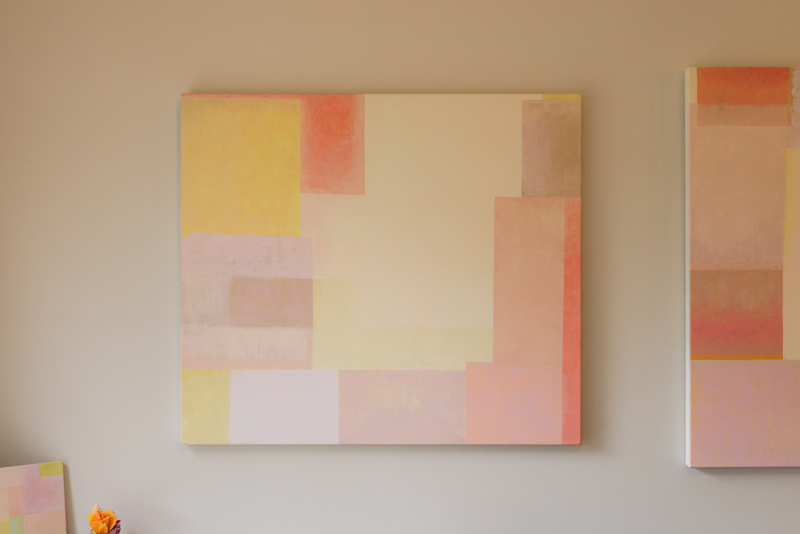
Suzanne Moss, Conversation with Julia’s Rose.
Image: © Grant Hardwick
A room of quiet
In terms of setting up such a room carefully, Dag Hammarskjöld was an exemplar. Creative director of The UN’s Meditation Room during the 1950s, the then Secretary General of The United Nations from 1953–61, Hammarskjöld together with chief architect Wallace Harrison sought a universal language and turned to the aesthetics and spirituality of abstract art. While speaking about the room, Hammarsjköld wrote in his papers (cited by Roger Lipsy in An Art of Our Own):
… This house, dedicated to work and debate in the service of peace, should have one room dedicated to silence in the outward sense and stillness in the inner sense. It has been the aim to create in this small room a place where the doors may be open to the infinite lands of thought and prayer.
Astutely, Hammarskjöld notes:
Modern art teaches us to see by forcing us to use our senses, our intellect and our sensibility to follow it on its road of exploration. It makes us seers … Seers—and explorers—these we must be if we are to prevail …
Hammarskjöld makes a fine case for using abstract art to change how we think; to take its exploratory lead so we can see further, imagine and be visionaries. His belief in modern art, realized through his creative directorship of The UN’s Meditation Room, deeply affirms Thich Nhat Hanh’s advice on making space for our own breathing and peace of mind.
The two functions of being visionary and breathing are interdependent, since in order to imagine, one’s neurophysiology must be in a calm, parasympathetic-dominant state and awareness of one’s breath is the most effective way to make the shift.
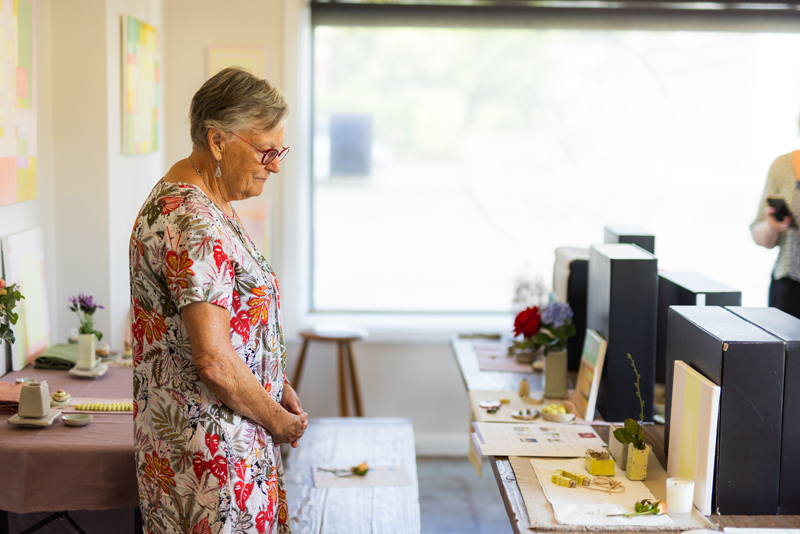
Jan Roberts OAM at the Morning Sanctuary Workshop.
Image: © Grant Hardwick
Listen
In the short film above recorded at a Morning Sanctuary workshop, you’ll see participants unwrap boxed sets containing a small painting, stoneware vessels, stones and beads, and a linen cloth. Each person sets up their space, with a sense of delight and agency as they creatively composed these things. Each installation was entirely different, reminding us of each person’s unique creative contribution.
Over the last 12 years of teaching painting, meditative art and coaching, I’ve spoken with many intelligent people who wanted to “be more creative” and dismissed their yearning as “silly”, “childish” and “I don’t have time”.
Refusing to listen to the wistful prompts of the heart, carries at the very least the troubling cost of regret. About denying “the call” to do what you would love, mystic poet Kahlil Gibran’s prophet (in The Prophet) advises:
But if in your fear you would seek only love’s peace and love’s pleasure,
Then it is better for you that you cover your nakedness and pass out of love’s threshing floor,
Into the seasonless world where you shall laugh but not all of your laughter and weep, but not all of your tears.
Following the prompts to live your dreams is a heroic journey; a way to move from an unfulfilled life; a way to ameliorate the ache of yearning or, as Bob Nickas wrote prosaically about abstraction—the antidote. Our dreams, desires, visions of alternate possibilities are addressed specifically to us. But we cannot know our dreams and what to do about them unless time is taken to listen, discern and contemplate them.
Creating a Morning Sanctuary space to be and think with contemplative art is a creative act integrative of body, mind and spirit. A way to feel whole within while being part of something larger, as happens with rituals, one does not have to be artistic to partake.
Rather than just being a nice thing to do, Hammarskjöld’s visionary project and exhortation to be seers conveys the imperative of imaginative exploration and seeking creative possibilities for the continuation of Life. As creative director of your space and own life, you can imagine, see, listen and attend to your heart’s yearning and in that truthful process love Life, love the world and blossom again and again.
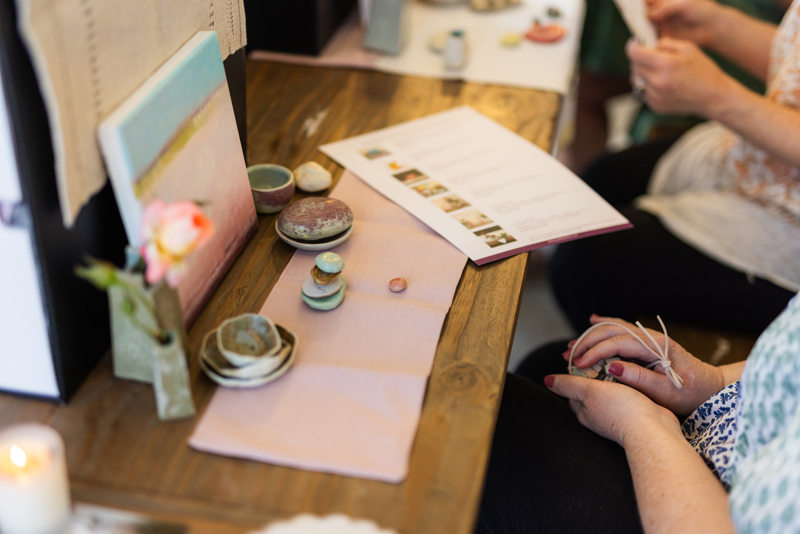
Morning Sanctuary Workshop.
Image: © Grant Hardwick
Post Notes
- Feature image: © Grant Hardwick, The Morning Sanctuary Exhibition Setting for the Workshop
- Suzanne Moss’ website
- Suzanne Moss: Love is a Place
- Ted Somogyi: World Peace Project
- Roberta Pyx Sutherland: Greater Silence
- Wassily Kandinsky: Concerning the Spiritual in Art
- Agnes Martin: Writings
- Chris Jordan: Beauty Emerging
- Armen Agop: Contemporary Spiritual Art
- Hannah Peschar Sculpture Garden & Zen Master Ryokan
- Antony Gormley: Sculpted Space Within and Without
- Dag Hammarskjöld: Markings
- The Culturium uses affiliate marketing links via the Amazon Associates Programme
